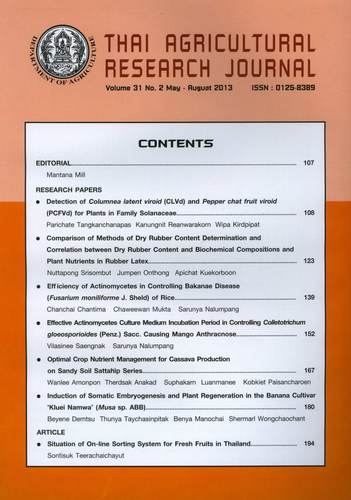Optimal Crop Nutrient Management for Cassava Production on Sandy Soil Sattahip Series
DOI:
https://doi.org/10.14456/thaidoa-agres.2013.17Keywords:
nutrient management, sandy soil, Sattahip soil seriesAbstract
To increase cassava production in present situation to costly chemical fertilizer, it should perform good nutrient management which is specified to production area. Therefore, the response of response of cassava to nutrient management in sandy soil Sattahip series in the eastern of Thailand had been investigated. The aimis are to get the most effectively recommendation of fertilizer application for cassava grown on sandy soils. The experiment was conducted on Sattahip (Sh) sandy soil, at Muaeng district, Rayong province. The experimental design was a split-plot with 3 replications. Main plot consisted of 3 varieties of cassava namely Rayong 9, Rayong 11 and CMR46-39-42 (Rayong 84-13). Sub-plot consisted of 10 fertilizer application namely 1) 0-0-0, 2) 16-8-16. 3) 16-8-0, 4) 0-8-16, 5) 6-0-16, 6) 16-8-8, 7) 8-8-16, 8) 24-8-16, 9) 16-8-24 and 10) 16-16-16 kg N-P2-O5-K2 O/rai. Results showed that variety and fertilizer affected cassava yield with significant differences. The cassava CMR46-39-42 varieties gave the highest yield of 6,255 fresh weight kg/rai and 2,579 starch yield kg/rai followed by Rayong 9 5,332 fresh weight kg/rai and 2,180 starch yield kg/rai while Rayong 11 gave the lowest yielding of 4,809 fresh weight kg/rai and 1,918 starch yield kg/rai cassava produced high yield and starch yield at level of nitrogen 24 kg N/rai, phosphorus 8 kg O2O5/rai and potassium 16 kgK2O/rai. The 3 cassava varieties differed from nitrogen and potassium uptakes except phosphorus. Use of nitrogen fertilizer at 24-8-16 kg N-P2-O5-K2 O/rai were the most benefit with the highest average net income 12,454 baht/rai which suited to the economic return.
Downloads
Published
How to Cite
Issue
Section
License
Copyright (c) 2017 วารสารวิชาการเกษตร (Thai Agricultural Research Journal)

This work is licensed under a Creative Commons Attribution-NonCommercial-NoDerivatives 4.0 International License.
Thai Agricultural Research Journal



